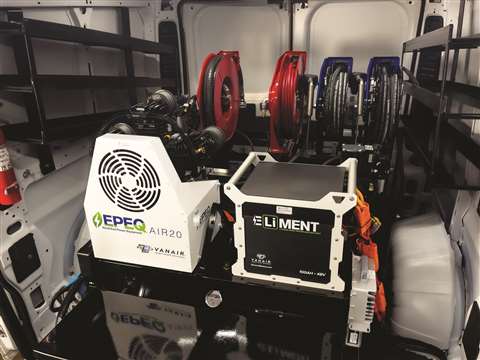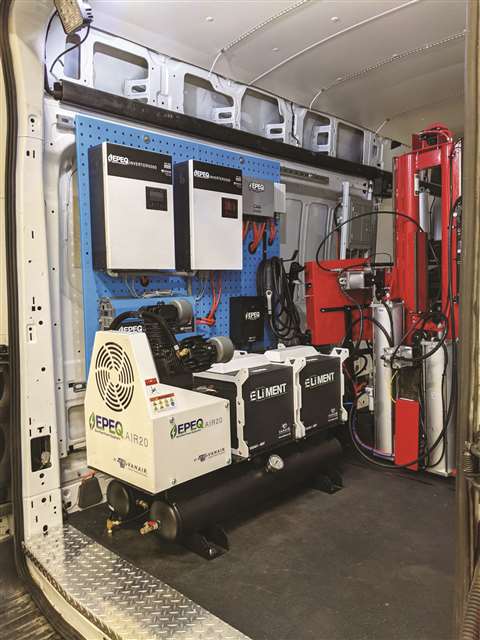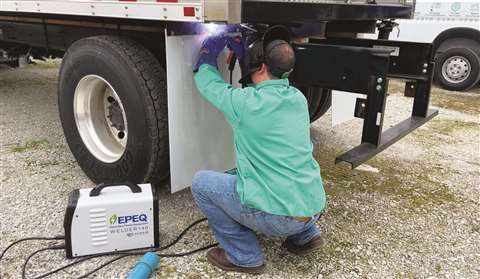Vanair has an EPEQ two years
23 March 2023
 EPEQ is a self-contained and independent system that can be installed in engine- and electric-powered vehicles as well as trailers. (Photo: Vanair)
EPEQ is a self-contained and independent system that can be installed in engine- and electric-powered vehicles as well as trailers. (Photo: Vanair)
Vanair Inc. has added an idle mitigation kit to its EPEQ Electrified Power Equipment product line, the latest component in a system it introduced two years ago. Designed to automatically turn off the host vehicle’s engine when certain parameters are met, the company said it will help fleets increase fuel savings, reduce emissions and maintenance costs and comply with regulations while powering cabin heat and air conditioning, emergency lights and strobes, laptops, cameras and more.
At the most basic level, EPEQ is a self-contained and independent system that can be installed in engine- and electric-powered vehicles as well as trailers. It is operated by a smart controller that communicates with its own set of ELiMENT lithium-ion iron phosphate batteries.
Each component within EPEQ works as a part of a battery-powered system. The catalog also consists of air compressors, AC power inverters, welders, Level 1 and 2 EV charging and DC-DC converters, alternators and regulars and an ePTO. Depending on the form of power required, a single-function machine can be ordered or the customer can select an entire ecosystem that will include all the tools needed for a certain job.
The company said the product group follows closely with its traditional product lineup in terms of markets and customers – many it’s worked with for 50 years. For example, the EPEQ line’s mobile electric vehicle charging system ties into the company’s history of vehicle starting via its Goodall product line.
Evolution
Dean Stratham, vice president of sales for Michigan City, Ind.-based Vanair, said the EPEQ line recently displayed at ConExpo-Con/Agg 2023 in Las Vegas has evolved since it was introduced during the 2021 Utility Expo, also hosted by the Association of Equipment Manufacturers (AEM). But it has stayed true to its original concept.
 EPEQ is a complete battery-powered system that has been especially popular in service truck bodies. (Photo: Vanair)
EPEQ is a complete battery-powered system that has been especially popular in service truck bodies. (Photo: Vanair)
“When we launched the product, we thought we had a well-rounded line of products to meet the needs of our customers,” he said. “But we’ve learned there are so many more applications for this product than we originally had in view. That’s opened our eyes to ways it would be used that we hadn’t considered. Some of the biggest changes we’ve made since it was introduced really emphasize the Vanair value, especially in how we fully integrate the product into the rest of the truck and how we get the components to communicate to make the system as efficient as possible.”
He said customer awareness of the product line and their adoption of it has really been exciting for Vanair’s engineers – and those of its customers — and has helped reveal some unexpected opportunities.
“Our early marketing opportunity was in people looking for a means to extend chassis life with features and benefits from products that were not readily available in the market,” said Strathman, “and now we’ve also heard from many people looking for solutions that are unique to their vocation or application. While they may not see, from a catalog perspective, that we’ve got something that fulfills their needs, they recognize that we have the technical expertise to help them develop exactly what they do need. We are working with some OEM companies to help develop and bring some new products to market. Once the awareness has gotten out there, it’s really had a cascading effect that’s taken us to a lot of different places.”
Zero-carbon solution
The company said the EPEQ line – the idle mitigation kit in particular – will help customers meet internal or state and federal mandates for carbon emission reduction without waiting for the delivery of a fully electric vehicle or the infrastructure that is required to support them.
“There is a very large service truck fleet that we do a lot of business with,” said Stratham. “It has a sustainability group that in 2022 made a bold statement that by 2025 they will cut their carbon emissions in half. We were able to illustrate that by simply putting our idle mitigation system on the internal combustion engined vehicles they have today, they could achieve that goal without going to electric vehicles. We’re in field trials with them right now.
“A lot of the EV vehicles that are out there today have either focused on over-the-road trucking or last-mile delivery, and most of the EV vehicle suppliers have not yet focused on the Class 3 through 5 vocational work truck. Customers have been highly encouraged and excited about what this product line will do for them.”
 The EPEQ product line includes a welder for field repairs. (Photo: Vanair)
The EPEQ product line includes a welder for field repairs. (Photo: Vanair)
Telematics, too
Another new feature is that EPEQ can be paired with a telematics package.
“Adding telematics to the EPEQ idle mitigation kit brings invaluable asset usage information to fleet managers,” said Chip Jones, strategic manager for the EPEQ Electrified Power Equipment product group, Vanair. “Reporting how often an air compressor, inverter, crane or other component is used will allow fleets to pinpoint where to make fleet investments accurately, and what components can be removed to save space and weight.”
The company said it had been investigating its path into IoT, or the Internet of Things, for several years. When it found that existing products didn’t have the ability to interface with all the connected equipment and pick up the data points for which some of its fleet customers were asking, Vanair decided to develop and launch its own telematics system.
“It provides all the same features, benefits and value that the large telematics companies are providing, such as geopositioning and speed and location,” said Strathman, “but it’s an integrated system that works with all of the connected equipment, as well. We started with electrification to help alleviate range anxiety, that fear customers have when they look at battery-powered equipment. We’ve been able to prove through demonstration and testing that it really will, but telematics can provide them that view in real time and help them to understand the state of the battery, the state of the connected equipment and real-time usage — it will also help them answer concerns such as, ‘am I overbuying on some of this equipment’?”
STAY CONNECTED




Receive the information you need when you need it through our world-leading magazines, newsletters and daily briefings.
POWER SOURCING GUIDE
The trusted reference and buyer’s guide for 83 years
The original “desktop search engine,” guiding nearly 10,000 users in more than 90 countries it is the primary reference for specifications and details on all the components that go into engine systems.
Visit Now
CONNECT WITH THE TEAM










